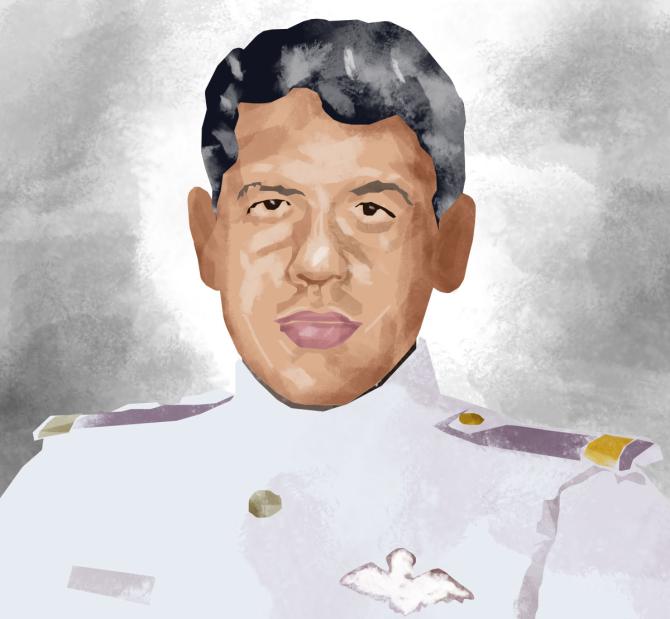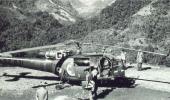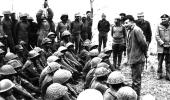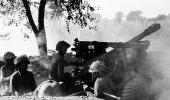'We airlifted army personnel wearing lungis to generally unused landing grounds.'
'We were told to keep quiet about what we did or saw.'
Air Commodore Nitin Sathe continues his fascinating year-long series on the 1971 War, 50 Years On.

I have run into Air Commodore Arun Dattraya Karandikar many times during my career in the Indian Air Force.
I knew him as the VIP pilot who only flew the President, the prime minister and other VIPs.
He was one of the first IAF pilots to be trained to fly the Boeing 737.
VIP trips for us helicopter boys meant picking up the VIP from the airport, transporting them to some remote helipad and getting them back to the airport where they would whisked away in the mighty jet flown by Air Commodore Karandikar or Kandy Sir as we called him.
These were short and sweet trips where we hardly got to see or interact with the VIPs.
We always looked up in awe at the communication squadron pilots who flew for long hours with these important people and got photographed with them too!
At that time, I did not know that Air Commodore Karandikar had been baptised by fire in the 1971 War.
Little did I know then that I would be interviewing him one day to find out about his exploits in 1971, flying the most intriguing aircraft -- the Dakota -- in the most remarkable and trying circumstances.
"On December 7, I was called by Group Captain Chandan Singh, the station commander, to fly to Kumbhigram (in Silchar, Assam) in the Dakota. What he said thereafter floored me. He asked, 'Are you confident about flying the Dak alone?'" Air Commodore Karandikar remembers.
Without waiting for an answer from the bewildered then Flying Officer Karandikar, the commander -- in his quintessential manner -- told him, 'Carry on! And safe flying!'
The Dakota was a transport plane meant to be flown by two pilots and two crew members. The cockpit was large enough and some of the switches and controls were accessible only to the co-pilot.
Flying Officer Karandikar sat down to think about how he would accomplish the duties of all the crew members in the cockpit without endangering the aircraft and its occupants. It was a tough ask and his thoughts took him back to his training days.
He had been posted to 43 Squadron in January 1971 to fly the Dakota.
The 'Dak', as it is known, had been in service for a long time in the IAF. The aircraft had been modified for military use from the original DC-3 variant; it could fly at about 250 kilometres per hour and go about 2,500 km on a full tank.
The aircraft had done yeoman service in the Second World War and continues to be in service even today.
On the occasion of India's 72nd Republic Day, it performed a fly-past at Rajpath. It also endeared audiences at the Aero India at the Yelahanka Air Force Base (in Bengaluru).
"I was commissioned in 1967 so I had already spent a few years in the IAF and had adequate experience on the An-12, which was the workhorse of the IAF at that time," says Kandy Sir.
Flying the Dak was new to him and he had to get operational on the aircraft by flying 100 hours in the NEFA (North-East Frontier Agency, as present day Arunachal Pradesh and parts of Assam were then known).
"I was called the 'Keen Kumar' of the squadron since I always volunteered for trips and was always ready to take to the skies. Gaining 100 hours wasn't easy. One barely got 15 to 20 minutes of captain flying whilst on the supply drop missions," he says.
But his perseverance ensured his logbook soon had the required flying hours and, within a few months, he became an instrument-rated captain on the Dakota.
The genocide in East Pakistan was all over the news at that time. Eastern India was flooded with refugees fleeing the massacres in East Pakistan.
"The entire Eastern Command was soon declared a disturbed zone under Operation Cactus Lily. For us flying officers, it meant that rations would be free and there would be no fat mess bills! It also meant that we would not get any dearness allowance," recalls Kandy Sir.
"Bunkers were being dug and camouflage painting coated the roofs. There was a flurry of construction activity all around, which signalled to us that something big was in the offing," he remembers.
"In early May, Flying Officer K S Rajan, Flight Lieutenant P C Chopra (navigator), Flight Lieutenant Biswas (flight signaller) and I were selected by our commanding officer, Wing Commander K C Sharma to fly as a detachment for the Eastern Command for about 15 days.
"We airlifted bridging and other equipment and army personnel wearing lungis to generally unused landing grounds like Ambari (Assam), Cooch Behar, Balurghat (both in West Bengal) on the border and also to Agartala (Tripura).
"We were told to keep quiet about what we did or saw. These places were in proximity to training camps where the Indian Army was training the Mukti Bahini.
"This entailed a lot of flying in the notorious pre-monsoon weather of that region. There were a few days when they flew with only lychees as sustenance during the entire day, resulting in achingly sour teeth and a rumbling stomach by evening."
During those flights, Kandy Sir met then Brigadier Shuhbeg Singh, the mercurial commander of the Counter-Insurgency School at Vairengte (Mizoram) and Colonel M A G Osmani of the Mukti Bahini.
The pilots of the squadron were soon sent to Agra to train for flying para-jump missions -- a very important requirement for the impending war.
And how did they land at these short and unused landing strips? Well, that is another interesting story!
These landing strips were just short kutcha (rough) runways that were unmarked. There was no Air Traffic Control and almost no one on the ground to ensure that it was safe to land.
Also, the flat grassy runway surface offered good grazing for cattle which invariably blocked the runway!
"We came in at a low level and then descended in a circuit pattern over the disused runway. Thereafter, it was mandated to do a couple of runs along the runway at very low levels to scare away the cattle after which we did a short circling approach to land," says the flying ace.
"There was just about the adequate length to stop the aircraft and often we had to land in tailwinds since only one direction was available for takeoff and landing. One had to sit on brakes and stop the heavily loaded aircraft. If the conditions were wet, there were chances of skidding on the muddy surface of the runway," remembers Ait Commodore Karandikar.
"Take-offs were dicier since the big bird would climb very slowly, just skimming the tree tops.
"The cattle soon were trained; they moved away as soon as we were overhead and were back grazing after we landed!" quips the war hero.
Part 2: 1971 War - A brave Dakota pilot's contribution
Air Commodore Nitin Sathe retired from the Indian Air Force in February 2020 after a distinguished 35 year career.
The author of three bestsellers, you can read Air Commodore Sathe's contributions here.
Feature Presentation: Rajesh Alva/Rediff.com










